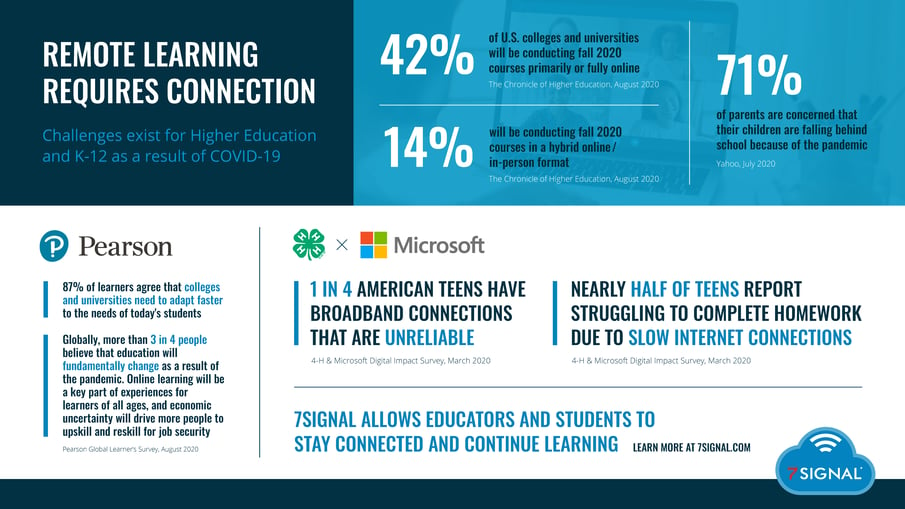
Blog
These are some of the most pressing challenges for schools as a result of COVID-19 and the shift to remote learning
The COVID-19 pandemic has changed the way almost all organizations operate. And the education industry has been especially hard hit, as traditional teaching models have been completely altered to rely on remote learning.
According to research from Yahoo, 71% of parents say they’re worried about their kids falling behind at school because of the pandemic. And they’re right to be concerned. Schools around the country have been struggling with the best way to deal with COVID-19 restrictions. Many are turning to fully remote learning environments or a hybrid model that also depends on an internet connection.
Here are a few of the biggest challenges facing education systems because of the pandemic:
Building remote classrooms
The Chronicle of Higher Education found that 42% of colleges and universities in the U.S. are holding classes online in fall 2020, either fully or primarily, and 14% will be using a hybrid model that includes both online and in-person learning. Schools for grades K-12 across the country are implementing similar solutions.
These new “classrooms” look a lot different and present unique challenges. Teachers of elementary school students, for example, have to find new and creative ways to keep young children engaged. Grading becomes more difficult, as well. Many educators are hesitant to demand a lot of their students in these new environments when students have other concerns to manage, like family issues, potential illness, and uncertainty about the future.

The education system is challenged by the shift to remote learning. Click this infographic to see a larger version.
The remote classroom brings these issues to the table alongside new software, hardware, and network requirements. There are often major learning curves for students and teachers of all ages when new platforms must be used to communicate with one another or complete required coursework.
A recent Pearson survey showed that most learners (87%) believe that higher education institutions must adapt faster to the changing needs of modern students.
Some remote changes may be permanent
Another issue that the education system is grappling with is the fact that many of these new demands could be permanent. The same Pearson data referenced above indicated that 75% of people worldwide think that education will fundamentally change because of COVID-19. They believe that online learning environments will be commonplace and more people will decide to learn new skills remotely to ensure job security.
Even though many Americans discuss what they'll do when things "go back to normal," it's clear from the last few months that no one really knows when that will be, or what it will look like. Regardless, educators and students are both tasked with adapting quickly and effectively.
Unreliable internet connections
A significant challenge in the new remote learning world is having an internet connection that is reliable and high-quality. It’s a requirement when courses are taught virtually, but many people don’t have sufficient resources.
One in four American teens have unreliable broadband connections, as the 4-H and Microsoft Digital Impact Survey showed. The same research indicated that almost half of teens in the U.S. have trouble completing their homework assignments because of a slow internet connection. This makes it much more challenging for schools to implement effective online learning plans.
IT staff and administrators must find new solutions that will improve connections and make it easier for learners to complete assignments and attend classes.
The team at 7SIGNAL understands just how tough it can be to depend on dispersed networks for remote learning. Our continuous network monitoring tools provide actionable insights that allow educational institutions to develop and maintain quality online learning environments—even across a diverse range of home networks.
Get in touch with us for more information about how our tools can smooth the transition to remote learning.
7SIGNAL® is a leader in Wireless Experience Monitoring. The 7SIGNAL platform is a cloud-based Wi-Fi performance management solution that continuously monitors the wireless network for performance issues—maximizing network uptime, device connectivity, remote worker productivity, and network ROI. The platform was designed to support the Wi-Fi management needs of the world's largest organizations, educational institutions, hospitals, and government agencies. 7SIGNAL continuously monitors the connectivity of over 5 million global devices. Learn more at www.7signal.com.